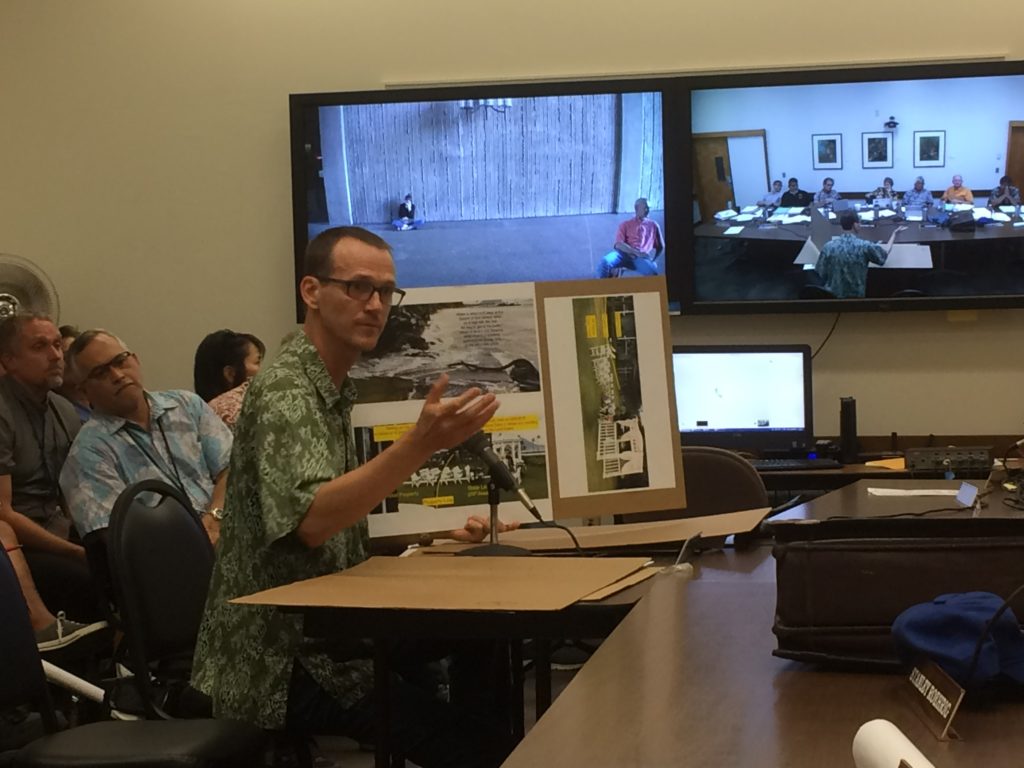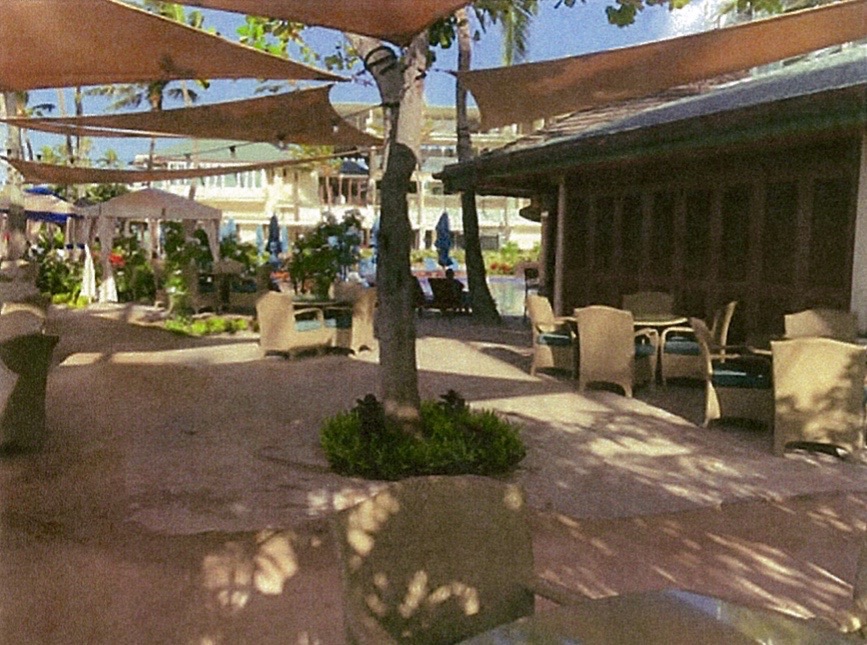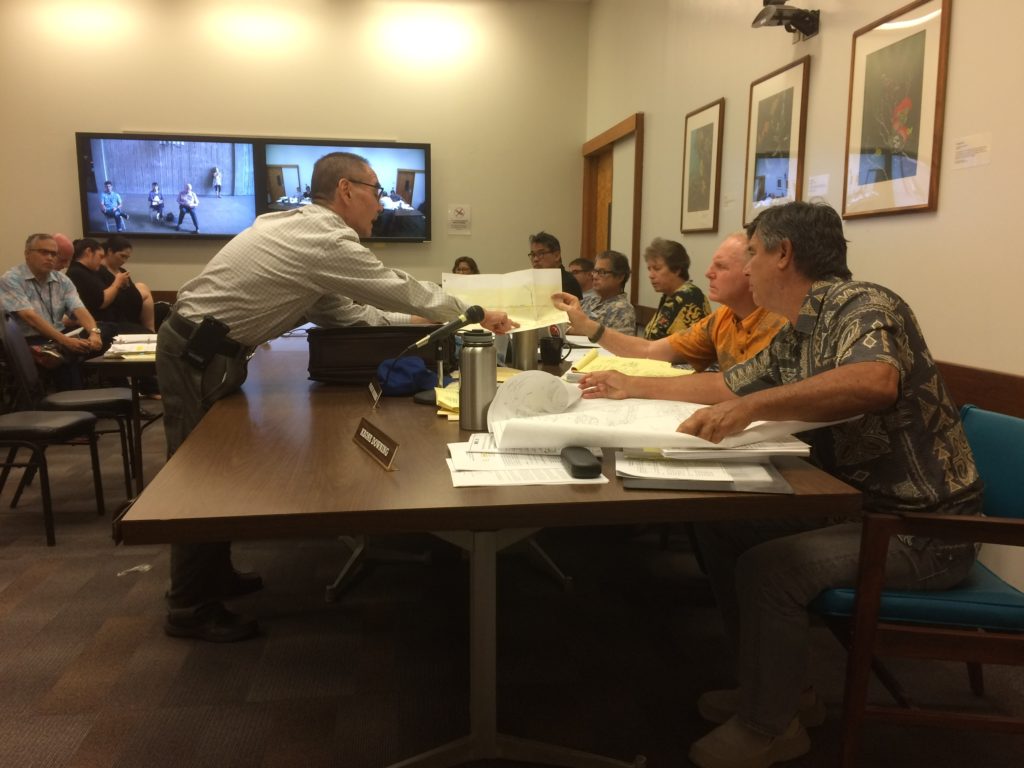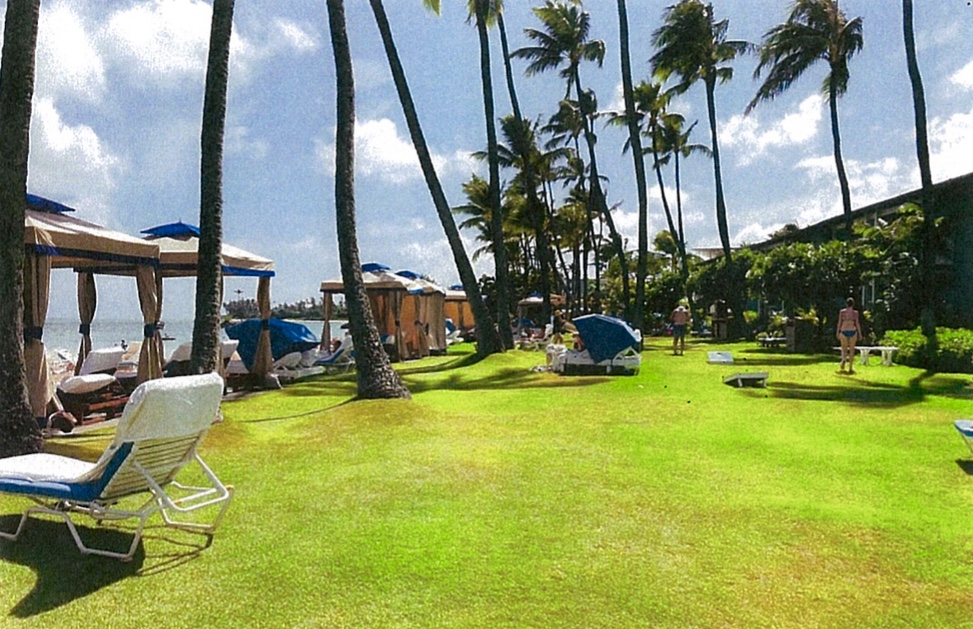In February 1967, officers with the Kahala Hilton Hotel Company signed an agreement with the state that allowed for the hotel’s creation of a public beach and swimming area fronting what is now the Kahala Hotel & Resort in south O`ahu, about four miles east of Waikiki.
The hotel used material dredged from the swimming area to fill sections of the coastline immediately seaward of the adjacent private properties, which included the hotel site. Regarding these filled areas, which have been largely grassed over, the agreement had this to say:
“Title to and ownership of all filled and reclaimed lands and improvements seaward of the makai boundaries of Land Court Applications Nos. 828 and 685” — the private lands upon which the hotel and other buildings sit — “shall remain in and vest in the state of Hawai`i and shall be used as a public beach.”
At the September 14 meeting of the state Board of Land and Natural Resources, this language seemed to have been largely overlooked in the hours-long debate over whether the board should grant the hotel a new revocable permit for dozens of “recreational” uses, some of which have the potential to generate hundreds of thousands, if not millions, of dollars for the hotel every year (and perhaps already have been doing so).
A contested case hearing request by attorney David Frankel prevented the Land Board from voting on a motion by member Chris Yuen to approve the permit. While Yuen said he shared Frankel’s concerns about authorizing commercial uses on the property, he seemed comfortable letting the hotel continue some of those uses for a while, so long as the department got a cut of gross revenues. “It can be looked at in a year,” he said before making his motion.
To Frankel, however, those uses needed to stop immediately, especially since they were never subject to an environmental review.
“You cannot grant an RP for the uses that they envision,” he told the board, adding that the Department of Land and Natural Resources’ Land Division recommendation that the previously unauthorized uses be exempt from the state’s environmental review process exhibited a “failure to understand the law.”
Given the discussion over the proposed revocable permit, that may not have been all the division failed to do.
Evolution
The Land Division’s recommendation for a new permit to cover some 40 different pre-existing uses on the RP site stemmed largely from a June complaint letter to Land Board chair Suzanne Case from the Sierra Club of Hawai`i. In it, the group described, and documented with photos, a litany of alleged unauthorized commercial uses — weddings, restaurant operations, lounge and cabana rentals, among other things — occurring within the permit area, despite the fact that the hotel’s permit allows for only recreational and maintenance uses.
The group claimed that during the day, the hotel’s equipment and structures took up more than half of the 1.28-acre state parcel and noted that the hotel’s website charges as much as $7,100 for beachfront weddings and $165 a day for the cabanas (it now charges $200). The group asked Case to investigate its claims and “to take vigorous enforcement action.”
In discussing the matter with the hotel’s attorneys, Land Division staff agreed with them that the permit’s requirement that uses be only recreational or maintenance-related was “too vague” and “creates ambiguity in terms of possible enforcement actions,” the division’s report states.
Attorneys Jennifer Lim and Jon Yamamura, representing hotel owner ResortTrust Hawai`i, LLC (RTH), argued that while it does store and charge for use of its cabana tents and clamshell lounge chairs ($200/day and $100/a day, respectively) that occupy lands covered by its revocable permit with the DLNR, such uses could be considered recreational.
“The term ‘recreational’ in RP 7849 means something, but it is not defined within RP 7849. The Oxford dictionary defines the word ‘recreational’ to mean ‘relating to or denoting activity done for enjoyment when one is not working,’” they wrote in an August 6 letter to Case. They also cited county land use ordinances throughout the state. Honolulu’s ordinance, for example, defines outdoor recreational facilities as “permanent facilities for active outdoor sports and recreation, other than golf courses. Typical uses include: parks, playgrounds, botanical gardens, golf driving ranges, tennis courts, riding stables…”
“While there may not be one uniform definition of the term ‘recreational,’ it is clear that in the context of permitted land uses, ‘recreational’ authorizes far more intensive use than mere access to property,” they wrote.
“RTH, as did prior owners of the hotel, views the recreation and maintenance rights granted under RP 7849 as allowing recreational uses that would normally be associated with the operations of the hotel, such as the placement of clamshell lounge chairs and cabana tents for hotel guests, as well as storage of those items. These types of uses have been ongoing for decades,” they wrote.
A previous revocable permit for the area held by the hotel’s owner in the 1980s covered a surfboard rack, volleyball and badminton courts, and a walkway. That was all. But over the years, new uses crept into the area without ever coming to the attention of the Land Division or the Land Board. For example, ResortTrust’s attorneys informed the division in the August 6 letter that nearly 2,000 square feet of the permit area had been used for open-air dining since 2008. (The company acquired the hotel in 2014.)
Efforts by the hotel in recent years to transition from a revocable permit to a long-term or permanent easement and to vastly expand its use of the area backfired after members of the public became aware of the scope of the proposal.
The hotel has since scaled back its footprint, removing all Seaside Grill seating and shade cloths from the permit area and ending its practice of pre-setting chairs and lounges on the beach. Even so, the hotel has sought to maximize the uses of the property and has proposed establishing 40 different “use” areas spanning some 5,000 square feet. The Land Division supported the idea and recommended on September 14 that the Land Board approve a new permit for it.
If approved, the permit would allow the hotel to store beach equipment; set up tents, lounges, and chairs; and even establish an overflow seating area for its Seaside Grill, among other things. Rent, which for years had held steady at $1,244 a month, would be set by appraisal. The division also proposed issuing right-of-entry permits for two corporate events to be held on the RP area this month.
Enforcement
In response to the Sierra Club’s June letter to Case, Land Division staff inspected the site, and even seemed to corroborate one of the group’s claims — that the cabanas and chairs for rent were set up on the parcel — but did not go so far as to call it a violation in its report to the Land Board. Rather than penalizing the hotel for weddings that had already been held, staff simply informed the hotel that the events were not allowed without prior approval.
When the Land Division’s proposal for a new permit came to the board, however, members of the public and the Office of Hawaiian Affairs (OHA) suggested that the board should fine the hotel, as well.
OHA public policy manager Jocelyn Doane urged the board to determine what violations had occurred and said some of them should warrant financial penalties. “Weddings, the restaurant, cabanas, loungers … other money-making activities [going on] for I don’t know how long, we should be thinking about compensation,” she said. Because the parcel is ceded land, OHA receives 20 percent of all revenue generated from it.
Community member Tyler Ralston, who said he’s frequented the area for decades, testified to and showed photos of weddings being held within the permit area well after Case issued a letter in July 2016 ordering the hotel to cease and desist such events because they are not allowed under the permit.
“There were two weddings on the same day in June after chair Case sent a letter saying no more weddings. … They’ve had many, many weddings,” he said.

Frankel also attested that about a year ago, hotel staff tried to stop him from traversing the RP parcel during a wedding there.
Hotel manager Gerald Glennon told the Land Board that it had stopped taking reservations for events planned on state lands immediately after he learned in the middle of last year about the prohibition of such events and provided the department with a spreadsheet detailing its event commitments.
Wedding revenue aside, Ralston estimated that the hotel may have generated some $2 million from food and alcohol sales and the rental of the tents and lounges on the property.
“Over the years, there was moderate commercial use. It ebbed and flowed. … With the recent owners, there’s not only been unprecedented use of the RP parcel [and] the end result is we’re being squeezed out,” he told the board.
In discussing whether or not to grant the new permit, Land Board member Stanley Roehrig argued that some effort be made to recover the restaurant income that was generated from the state parcel.
Glennon told him that because the restaurant serves food not just to Seaside Grill customers, but to the pool and beach area, it’s hard to decipher how much money was generated from those seated on the state parcel.
“Waiters and waitresses have table numbers,” board member Keone Downing noted.
“They have sections,” Glennon replied, adding later that since the hotel has removed the seating from the permit area, the restaurant has taken “significant hits in revenue.”
In any case, Roehrig wanted some accounting of any ill-gotten gains.
“Whatever we do is precedent. … We try to treat everybody the same,” he said, adding later that he didn’t think it was in the public interest to ignore the matter.
Board member Yuen, however, seemed less inclined to dig up the past since he wasn’t sure if the Land Division ever objected to the restaurant seating. He said he would defer to the Department of the Attorney General on that issue.

Blurred Lines
In addition to recommending that the Land Board pursue enforcement, OHA’s Doane urged it to “take a step back” and consider whether a disposition of beachfront property that includes commercial uses was appropriate.
“With long-term dispositions, three decades in this case, often times lessees feel some vested ownership [and] when that’s unchecked, we find ourselves in situations like this,” she said.
“If you’re going to allow commercial uses, you shouldn’t lump them in with recreational uses. It could start a bad precedent and be confusing for other permittees,” she continued.
Land Division administrator Russell Tsuji, however, said that this particular property fronting the hotel was different from a normal beach, where commercial uses are generally prohibited. “The reason I’m in support, I did the ‘but for’ analysis. But for Kahala creating the beach, you would have what you have in the rest of the stretch” — a rocky shoreline and no good swimming areas. “I think there was a benefit, clearly,” he said.
He then stressed that neither the 1960s agreement with the hotel, nor the subsequent RPs prohibited structures from being placed in the permit area. Therefore, he argued, the hotel’s request to use 5,000 square feet for seating, showers, storage, etc., was reasonable.
“How about construction of a restaurant? How’s about putting up a hotel right there? If you could put a restaurant, you could put a building,” Roehrig said.
Tsuji started to explain that the permit was modeled after the leases of fast land issued by his division, when Roehrig continued, “This says ‘recreation and maintenance,’” referring to the permit’s proposed uses. “In order to have a restaurant and bar, that requires only ‘recreation’ or something different? If we have a building there two stories tall, is that recreation?” he asked.
Tsuji replied that the hotel argues that the lounges, cabana tents, and restaurant seating are consistent with recreational use. “It’s a real broad category and can be subject to many interpretations. It’s best to articulate what, exactly, is recreation and maintenance … and to itemize,” he said.
With regard to the proposal to set up chairs, lounges and cabanas within the permit area, board member Downing asked how the land fronting the Kahala hotel differed from the beaches in Waikiki or Kaanapali, where the department has prohibited pre-setting of such things.
The department has also stopped the Kahala hotel’s practice of presetting on the sandy beach and Downing suggested the permit area should be treated the same.
“To me, it’s the beach,” he said of the permit area.
Board chair Case interjected that the public beach was below the shoreline and was not subject to the proposed permit. “This disposition is from the shoreline up. … Although it’s related, this disposition doesn’t cover the beach,” she said. (This despite the language in the 1960s agreement stating that the filled lands shall be used as a public beach.)

Even so, Downing told Tsuji, “This is my point to you: where the grass is now is probably reclaimed beach. It was not grass. Just because we grow these things or put a wall up doesn’t mean it’s correct. … When they built that hotel, it was not on land that it looks like today. I’m trying to understand because I’m in a position where I’ve got to be fair.”
To Tsuji, however, the land wasn’t the beach. It was reclaimed land, not so different in terms of usability from Sand Island Industrial Park, he told Downing.
“Where are you trying to take me with this?” Downing asked.
“They’re using it as land,” Tsuji replied.
Regardless of how the parcel itself is defined, Frankel echoed points raised by Doane and others that some of the recreational uses being proposed were clearly commercial. He pointed out that Hawai`i Administrative Rules for unencumbered state land (including beaches) defines commercial activity as “the use of or activity … for which compensation is received by any person for goods or services or both rendered to customers or participants in that use or activity.”
Rent
In its June letter to Case, the Sierra Club argued that commercial use of beachfront property was inappropriate. But if the Land Board chose to allow the hotel’s uses to continue, the group recommended that it should charge $200,000 a month.
According to the Land Division’s recommendation, an appraiser would determine fair market rent for the hotel’s use of 5,153.5 square feet of the 1.28-acre parcel.
Tsuji told the board that if the parcel had been created without government approval, it would be valued as fast land, but because the state gave its approval, it would be valued as submerged land. Appraisers commonly set the value of submerged lands as a percentage of the value of adjacent fast lands. The more dependent the fast land uses are on the submerged lands, the higher that percentage is. If the uses are significantly dependent, an appraiser might value submerged lands as high as 50 percent of the value of the fast lands.
Downing pointed out that the hotel’s estimate that it will need exclusive use of about 5,000 square feet was based on the measurements of each item it wants to keep there. “It had nothing to do about the use of the product,” he said, noting that once all the clamshell lounges and cabanas are set up, there won’t be much room for the public. “You’ve got to look at the totality of the uses, not the square footage of the chair. … They should be charged for the area, not the equipment,” he said.
Frankel argued that if the state can only charge ResortTrust rent based on submerged land values, “why let these guys lease it at all? There’s so little money.”
Whether or not the public was allowed to use the parcel would also factor into the permit’s value as well. But in discussing whether or not the public could use the permit area, it again became clear that few understood that the area originally was to be used as a public beach.
“Does the public have the right to just go and sit on the RP right now? Is there any signage that explains that? I’ve seen the sign that says, ‘public access,’ which is different,” Yuen asked Tsuji.
Tsuji replied that the permit does not provide for exclusive use by the hotel.
Case said if the permit is going to be for non-exclusive use, “we should be clear,” she said.
In his motion to approve the permit, Yuen proposed adding amendments to make it clear that public use is allowed except in areas authorized for the hotel’s exclusive use and to establish a marked path with signage for public lateral access on the Diamond Head side of the parcel.
“The toughest issue is the request for commercial uses … the rentals, the overflow [restaurant] seating ,” he said. He suggested that the covered chairs should be clustered and include gaps to ensure the public can maneuver around them.
“I agree with David Frankel’s comments. Is it worth it what we get out of these uses? … If the commercial uses paid for two to three schoolteachers or [conservation enforcement] officers, OK. But if it’s $1,200 a month? No,” Yuen said.
Downing seemed to suggest that money wasn’t the only issue to consider. “What about [uncovered] beach chairs? If they’re free, do they get 200 of them?” he asked.
Yuen ultimately proposed charging the hotel 10 percent of its gross income from the parcel, pending the outcome of the appraisal, which he asked be brought to the board. Case added that charging a percentage rent — rather than something just based on a submerged land value — be considered in the appraisal.
When the hotel’s attorney Jennifer Lim interjected that the hotel already spends $250,000 to $300,000 a year maintaining the property and infrastructure on the state parcel, Downing reminded her that the state wasn’t the only beneficiary of that work. “You’re doing it for yourself,” he said.
Before the board could vote, Frankel asked for a contested case hearing, which prevented the board from taking action on the permit. In his follow-up written petition, Frankel stated that his “recreational, aesthetic and environmental interests would be adversely affected” by the hotel’s use of the permit parcel, as well as the beach and ocean areas, if the permit were renewed or a new one is issued under the conditions proposed by the Land Division.
(For more background on this, see, “Kahala Hotel Beach Weddings Not Sanctioned by DLNR Permit,” from our July 2017 issue and our September 2018 “BOARD TALK” column. Both are available at www.environment-hawaii.org)
— Teresa Dawson





Leave a Reply